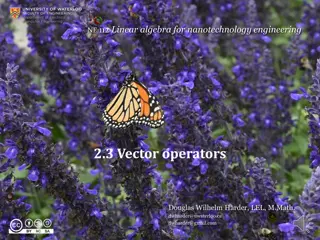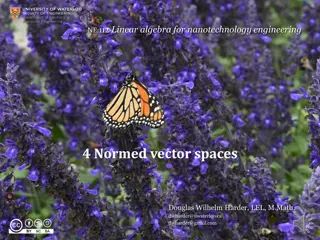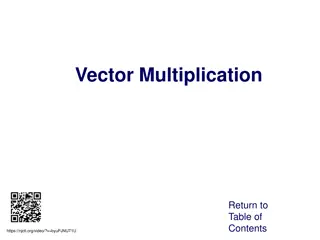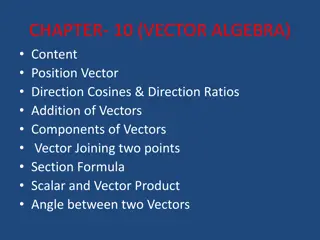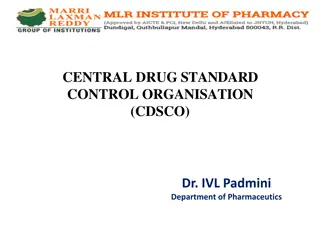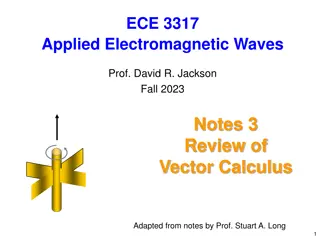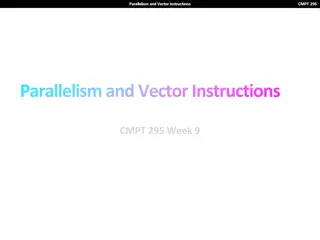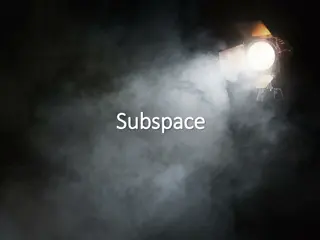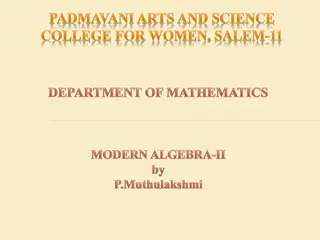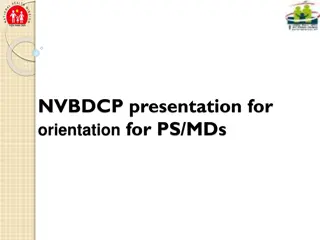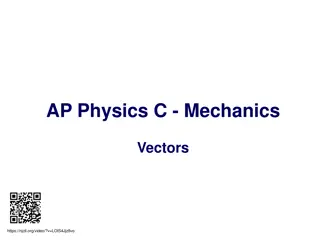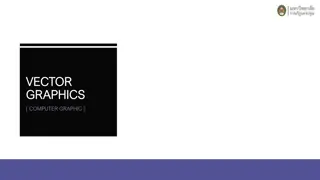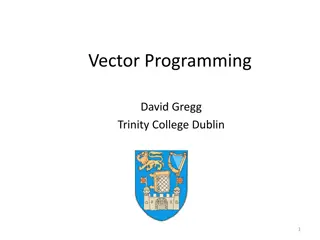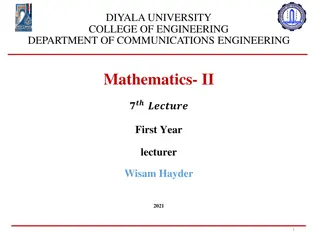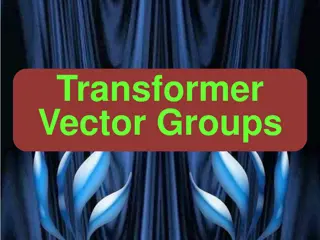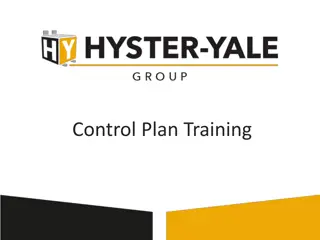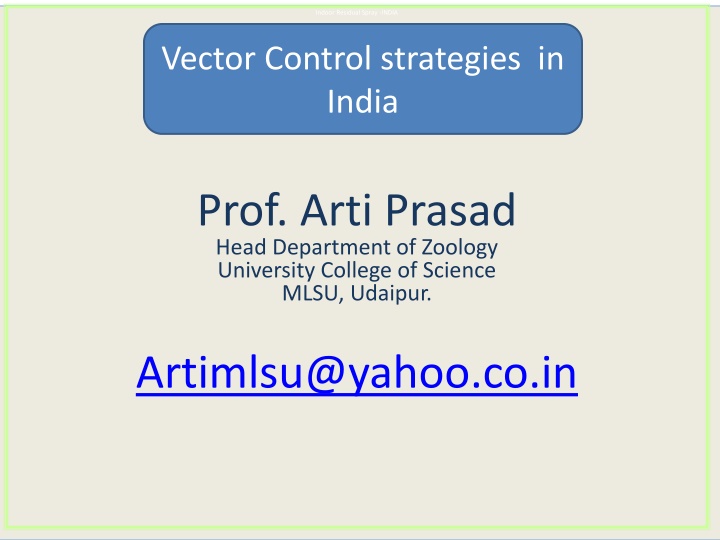
Vector Control Strategies in India: Targets, Vectors, and Objectives
Learn about India's milestones in malaria elimination, major disease vectors in India, objectives of vector control, and various aspects of vector control to combat diseases spread by mosquitoes.
Download Presentation

Please find below an Image/Link to download the presentation.
The content on the website is provided AS IS for your information and personal use only. It may not be sold, licensed, or shared on other websites without obtaining consent from the author. If you encounter any issues during the download, it is possible that the publisher has removed the file from their server.
You are allowed to download the files provided on this website for personal or commercial use, subject to the condition that they are used lawfully. All files are the property of their respective owners.
The content on the website is provided AS IS for your information and personal use only. It may not be sold, licensed, or shared on other websites without obtaining consent from the author.
E N D
Presentation Transcript
Indoor Residual Spray -INDIA Vector Control strategies in India Prof. Arti Prasad Head Department of Zoology University College of Science MLSU, Udaipur. Artimlsu@yahoo.co.in
Milestones and Targets for Malaria Elimination Eliminate malaria from all 15 low transmission states and UTs (Category 1) and 3 additional progressive states and UTs of Category 2 By 2020 Eliminate malaria from all 8 moderate transmission states and UTs (Category 2) By 2022 Reduce the incidence of malaria to less than 1 case per 1000 population in all states and UTs and their districts By 2024 Interrupt indigenous transmission of malaria throughout the entire country, including all 10 high transmission states and UTs (Category 3) By 2027 Prevent the re-establishment of local transmission of malaria in areas where it has been eliminated and maintain national malaria-free status By 2030 and beyond
Major Disease Vectors in India Malaria An. culicifacies, An. fluviatilis, An. minimus An. sundaicus, An. stephensi, An. dirus Dengue,Chikungunya, Zika v Ae. Aegypti, Ae. Albopictus Filariasis Cx. quinquefasciatus, Ma. annulifera and uniformis Japanese Encephalistis Cx. Vishnui gp, Cx. tritaeniorhyncus etc. Kala azar--- Sand fly
OBJECTIVE OF VECTOR CONTROL To Reduce female vector density to a level below which epidemic vector transmission will not occur Based on the assumption that eliminating or reducing the number of larval habitats in the domestic environment will control the vector The minimum vector density to prevent epidemic transmission is unknown
ASPECTS OF VECTOR CONTROL Which mosquito species are locally important as vectors of diseases? Which mosquito species are important as the primary source of annoyance? What are the important breeding sites of different mosquito species? What is the seasonal pattern of mosquito breeding? What are the resting places of adult mosquitoes? What are the feeding preferences of vector mosquitoes? To map out and locate all potential larval development habitats. To identify the mosquito species present. To predict the time and location of effective control strategies.
Vector Control INDIA National Policy for use of Insecticides : CIB registration of any Insecticide / Larvicide for public health use is Mandatory. Expert Group on Vector Control Technical Advisory Committee (TAC) on VBDs DDT Mandate Committee Common Protocol to undertake field trials through ICMR Institutions / NCDC Operational Research by ICMR/VBD Science Forum, NIMR, VCRC, NCDC, Universities
Insecticide Policy Programme uses insecticides for indoor residual spray, indoor/ outdoor space spray, treatment of mosquito nets, LLINs, larvicides for vector borne diseases control Change of insecticides under NVBDCP is based on susceptibility status and epidemiological impact Introduction of New Compund: The manufacturer/importer of new pesticides / formulation of pesticides listed under the schedule of Insecticide Act (1968) need to submit requisite data to get it registered with CIB for its use under programme CIB & RC gives registration/approval based on the data submitted by the manufacturer as per the guidelines of the Registration Committee
VECTOR CONTROL Strategies Environment Management Environmental Control Biological Control Chemical Legislative control Biological Control Chemical Control Control INTEGRATED VECTOR MANAGEMENT An Evidence-based decision making process, rationalizing the use of vector control methods and emphasizing the engagement of communities
IVM-Vector Control Vector control programme in India and elsewhere, in world, mostly rely on natural and synthetic chemical molecules having potential to kill vectors Presently different formulations of synthetic chemical insecticides are in the use for vector control. Mainly Wettable powder (WP) formulations are used for indoor residual sprays while emulsion concentrate (EC)/granule formulations are used for larval control.
IRS - Insecticide Dosage, Dilution and Requirement INSECTICIDE DOSAGE PER Sq. m. (a.i.) DILLUTION PER 10 LTR. OF WATER (covers 500 sq m area) INSECTICIDE FORMULATION PER HOUSE (150 Sq. m) PER ROUND AVERAGE PER 5000 POPU. (or 1000 houses)PER ROUND TOTAL PER ANNUM DDT 50%* 1 gm 1 Kg 300 gm 375 Kg 750 Kg Malathion 25% (2 coats and 3 rounds per annum) 2 gm 2 Kg 1200 gm 1500 Kg 4500 Kg Deltamethrin 2.5% 20 mg 400 gm 120 gm 50 Kg 300 Kg Cyfluthrin 10% 25 mg 125 gm 37.5 gm 46.87 Kg 93.75 Kg Lambdacyhalo- thrin 10% 25 mg 125 gm 37.5 gm 46.87 Kg 93.75 Kg Alphacyperme- thrin 5% 25 mg 250 gm 75 gm 93.75 Kg 187.50 Kg
LARVICIDE FORMULATIONS AND DOSAGE S.No. Name of Larvicide Commerci al formulatio n Preparatio n of ready to spray formulatio n 1 square meter 50 Linear meter Per Heactare Frequency of application Equipment required remarks 1 MLO 100% petroleum project product As it is 20 C.C. 1 Litre 200 Litres Weekly Knapsack/ hand compressi on sprayer To be applied along the shore of water body 2 Temephos (Abate) 50% EC 2.5 c.c. in 10 litres of potable water 20 C.C. 1 Litre 200 Litres -do- Knapsack/ hand compressi on sprayer Can be applied in clean water 3 Bacillus thuringiensisva r israelensis WP Wettable powder 5 kg in 200 litres of water - - 5 kg Fortnightl y Knapsack/ hand compressi on sprayer For both clean and non- potable polluted water 4 Bacillus thuringiensisva r israelensis 12 Aqueous Suspension Aqueous suspensio n 12 Aqueous Suspensio 1 litre in 200 litres of water - - 1 Lit. Weekly Knapsack/ hand compressi on sprayer Clean water In the case of Malathion, the requirement shown above, is for the three rounds (AS) n 200 litres of water 2 litres in - - 2 Lit. Weekly Knapsack/ hand compressi on sprayer Polluted water
LARVICIDE FORMULATIONS AND DOSAGE S.No. Name of Larvicide Commerci al formulatio n Preparation of ready to spray formulation Per Heactare Frequency of applicatio n Equipmen t required remarks 5 Diflubenzuron IGR 25% Wettable Powder 100 gms (25 gm a.i) in 100 Litres of water (10 g in 10 litre) 100 litre Clean 100 lit. Weekly Knapsack / hand compressi on sprayer To be applied along the shore of water body Clean water ------------ Polluted water 200 lit Water 200 gms (50 gm a.i) in 100 Litres of water (20 g in 10 litre) 6 Pyriproxyfen GR 0.5% Granular Ready to use 2 kg. Clean Water 3 weekly Manual clean water ------------- Polluted Water --------------------------- --- 4 kg. polluted water
Space spray-Dosage, Dilution and Requirement INSECTICIDE Dosage DILLUTION 1. Pyrethrum Extract 2% Extract 1 part of 2% Pyrethrum Extract in 19 parts of Kerosene (50 ml in 1 litres K.Oil Used for Indoor Space Sp 2. Malathion Tec. OP 1:19 i.e.1 part of Malathion Tech in 19 parts of Diesel (50 ml in 1 litres diesel) Used for out door thermal fogging 5%EC 3 Cyphenothrin Synthetic pyrethirod 0.5 mg a.i per sq.mt. (20 ml in 1 litres K.Oil) Used for Indoor Space Sp 3.5 g a.i per hactare (7 ml in 1 litres diesel Out door thermal fogging 4. Cyphenothrin 5%EC
Emergency vector control Thermal fogs are produced when an insecticide formulation condenses after being vaporized at a high temperature. These formulations can be oil-based or water-based; the oil (diesel)- based formulations produce dense clouds of white smoke, whereas water-based formulations produce a colorless fine mist. Hot gas is used to heat the pesticide spray, decreasing the viscosity of the oil carrier, and vaporizing it. When it leaves the nozzle the vapour hits colder air and condenses to form a dense white cloud of fog. Most of the droplets are smaller than 20 m. The droplet size is affected by the interaction between the formulation, the flow rate and the temperature at the nozzle (usually > 500 C). The volume of spray mixture applied in vector control is usually 5 10 litres per hectare, with an absolute maximum of 50 litres per hectare.
Environmental Control SABARMATI RIVER S CHANGING SCENARIO ENVIRONMENTAL MODIFICATION and malaria control SCENIRIO Intervention:Channelization Sabarmati: erstwhile Narmada Fed Sabarmati
Legislative control-An. ste[phensi Model Civic Bye-laws and Building Bye-laws for prevention and control of vector breeding Model Civic Bye-laws: Promulgation and implementation with provision to prevent /eliminate mosquito breeding like Municipal Corporation of Greater Mumbai, NCT Delhi, Chandigarh, Bhopal, Agartala, Navi Mumbai Municipal Corporation, Thane and Goa. Building Bye-laws: Provision to prevent mosquitogenic conditions on the exterior of the buildings and clauses in the contract to keep curing tanks free of mosquito breeding during construction phase and dismantling of the same before issuance of occupancy certificate like Navi Mumbai
Navi Mumbai Municipal Corporation Malaria Bye-laws : To reduce future potential breeding places fpr Anopheles stephensi. Inspect the site for any potential breeding places at the construction. No Objection Certificate is issued from Health Department of NMMC for Occupancy. 17



